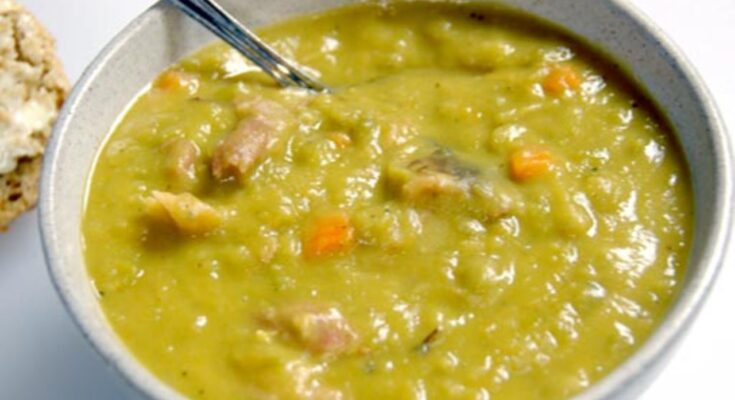Split Pea and Ham Soup Recipe: There’s something undeniably nostalgic about a bowl of split pea and ham soup. It’s the kind of dish that feels like a warm hug on a cold day, isn’t it? Thick, hearty, and loaded with flavor, this soup has stood the test of time as a comforting favorite across generations. Whether you’re using leftover ham from a holiday meal or a smoked ham hock for that deep, savory flavor, this soup is the perfect way to transform simple ingredients into a satisfying meal.
Split pea and ham soup is also surprisingly healthy. Peas are packed with protein, fiber, and essential vitamins, while ham adds a robust, smoky depth. This is one of those recipes that feeds the body and the soul—and it only gets better the next day, making it an ideal make-ahead meal. Let’s break it all down step by step, so you can whip up a batch like a seasoned home chef.
Ingredients Overview
Before we dive into cooking, let’s take a moment to understand what goes into this hearty bowl of goodness.
Main Ingredients
- Split peas (1 pound): Green split peas are the star of the show. They break down beautifully as they cook, creating that creamy texture without any need for cream.
- Ham (2 cups diced or 1 ham hock): Whether you’re using leftover baked ham or a bone-in ham hock, this ingredient provides the rich, meaty backbone of the soup.
- Vegetables: Classic mirepoix—onion, carrots, and celery—is essential for flavor.
- Garlic (2 cloves, minced): Adds depth and a hint of spice.
- Bay leaf and thyme: Aromatic herbs that balance the soup’s richness.
- Chicken or vegetable broth (6-8 cups): For a more flavorful base than plain water.
Choosing the Best Ham
If you’re using leftover ham, make sure it has a good smoky crust—this adds extra flavor. A smoked ham hock or shank will also give your soup that deep, umami essence and works perfectly in long simmered soups. If you go with deli-style ham or anything low-sodium, remember to adjust the seasoning accordingly.
Fresh vs. Dried Peas
Always go with dried split peas for this recipe. Canned peas don’t have the same texture and tend to get mushy fast. Dried split peas don’t need soaking, unlike beans, which makes prep easier. Just give them a good rinse before adding to the pot.
Kitchen Tools You’ll Need
Don’t worry—this soup doesn’t require fancy equipment, but having the right tools makes the process smoother.
Must-Have Utensils and Cookware
- Large soup pot or Dutch oven: Preferably 6-quart or larger, heavy-bottomed to prevent burning.
- Sharp knife and cutting board: Essential for prepping the veggies and ham.
- Wooden spoon or spatula: For stirring without damaging your pot.
- Ladle: Makes serving a breeze.
Time-Saving Kitchen Gadgets
- Immersion blender (optional): If you like your soup ultra-creamy, a stick blender is a game changer.
- Slow cooker or Instant Pot: Want to set it and forget it? These tools adapt beautifully for this recipe.
Step-by-Step Recipe Instructions
Let’s roll up our sleeves and get cooking. This method keeps it simple and approachable—even for beginner cooks.
Step 1: Preparing the Ingredients
Start by rinsing your dried split peas under cold water. You want to remove any debris or small stones (it happens). Then, dice your onion, carrots, and celery evenly. If using a ham hock, no prep is needed; if you’re using diced ham, cut it into bite-sized cubes.
A tip? Get all your ingredients prepped and laid out before you start cooking. It’ll make the whole process smooth and stress-free.
Step 2: Sautéing for Flavor
In your soup pot or Dutch oven, heat a bit of oil or butter over medium heat. Add your chopped onions first and cook until translucent—about 3 to 5 minutes. Then add your carrots, celery, and garlic. Sauté everything together for another 5 minutes. This step builds a solid flavor foundation for your soup.
Next, if you’re using diced ham, toss it into the pot and let it brown slightly. This caramelization adds a ton of flavor. If using a ham hock, add it in the next step.
Step 3: Simmering to Perfection
Pour in your broth (start with 6 cups and add more if needed) and stir in the split peas. Add your bay leaf and a pinch of thyme. If using a ham hock, nestle it into the pot now.
Bring everything to a gentle boil, then reduce to a simmer. Cover loosely and let it bubble gently for about 60-90 minutes. Stir occasionally to prevent sticking. The peas should start to break down and the soup will thicken naturally.
Once the peas are tender and the soup is nice and thick, remove the ham hock, if used. Let it cool slightly, then shred the meat and stir it back into the pot.
Step 4: Blending for Creaminess (Optional)
This step is totally up to you. If you love a smooth texture, use an immersion blender to partially or fully blend the soup right in the pot. You can also scoop some soup into a traditional blender—just be careful with hot liquids.
Prefer a chunky, rustic vibe? Skip the blending and enjoy the texture as is. Either way, the soup will be delicious.
Step 5: Final Seasoning Touch
Taste your soup before seasoning—ham can be salty, so you may not need much extra salt. Add black pepper to taste, and maybe a pinch of smoked paprika or a dash of vinegar if it needs a little zing.
Let the soup rest for 10 minutes before serving to let the flavors settle. Serve with crusty bread or a warm biscuit on the side.
Tips for the Perfect Split Pea and Ham Soup
Getting the most out of your ingredients is the key to making a next-level split pea and ham soup. Here are some practical tips that will elevate your soup game from good to unforgettable.
How to Avoid a Mushy Texture
Split peas naturally break down as they cook, which helps give the soup its iconic creamy texture. But there’s a fine line between creamy and gluey. Here’s how to avoid going overboard:
- Don’t overcook: Once the peas are soft and start to dissolve, turn off the heat. Cooking them too long will give your soup a pasty consistency.
- Skip excessive stirring: Constant stirring breaks the peas down even more. Gentle, occasional stirring is best.
- Use fresh split peas: Older peas can take forever to cook and may break down unevenly, resulting in a less-than-ideal texture.
Another pro tip—if you’re making a big batch and storing leftovers, don’t overheat it when reheating. Bring it to a gentle simmer and add a splash of broth or water to thin it out.
Secrets to Richer Flavor
This soup might be simple, but the flavor doesn’t have to be basic. Want to make it taste like something straight out of a rustic farmhouse kitchen? Try these:
- Use homemade stock: Chicken or vegetable broth made from scratch adds an unbeatable depth of flavor.
- Add a smoked element: A ham hock or smoked turkey leg adds a lovely smoky essence. If you’re vegetarian, a dash of liquid smoke can help.
- Caramelize your vegetables: Let the onions and carrots get a little brown in the pan. Those caramelized bits at the bottom are gold.
- Add acidity at the end: A splash of vinegar or squeeze of lemon right before serving helps cut through the richness and brightens everything up.
Another trick? Let the soup rest overnight in the fridge. The flavors deepen and mellow, making tomorrow’s leftovers taste even better.
Common Mistakes to Avoid
Even a seemingly simple dish like this can go sideways if you’re not careful. Here are the common pitfalls and how to steer clear:
- Not rinsing split peas: Always rinse and sort your peas. Nobody wants to bite into a pebble.
- Skipping the sauté: Raw veggies straight into boiling broth? Big mistake. Sautéing first brings out sweetness and complexity.
- Adding too much salt early on: Ham is salty. Wait until the end to season properly.
- Cooking too hot: Keep it at a low simmer. A rapid boil can make the peas tough and unevenly cooked.
- Neglecting the ham bone or hock: If you have it, use it! The marrow and meat infuse incredible flavor.
Getting these right might take a little trial and error, but once you do, this soup could easily become a go-to in your recipe rotation.
Serving Suggestions
This soup is a meal all on its own, but pairing it with the right side or topping can take things to the next level.
Perfect Pairings
- Crusty sourdough bread: Great for dipping and mopping up that thick, savory soup.
- Cornbread or biscuits: A slightly sweet contrast that balances the salty ham.
- Simple green salad: Light and refreshing, it balances out the soup’s heartiness.
Garnish Ideas
- Chopped fresh parsley or chives for color and freshness.
- A dollop of sour cream or crème fraîche for tang.
- Crushed red pepper flakes for a bit of kick.
- Homemade croutons or bacon bits for texture.
Keep in mind—this is a rustic soup, so no need to overthink the presentation. Just keep it warm and hearty.
Storing and Reheating
One of the best things about split pea and ham soup? It stores and reheats like a champ.
How to Store
- In the fridge: Cool completely, then transfer to an airtight container. It’ll keep for up to 5 days.
- In the freezer: Pour into freezer-safe containers, leaving room for expansion. It lasts up to 3 months. Thaw overnight in the fridge before reheating.
Reheating Tips
- Use a saucepan on the stovetop over low heat.
- Add a splash of broth or water to loosen the soup.
- Stir occasionally to heat evenly.
- Avoid microwaving in plastic containers—go for glass or ceramic.
Freezing tip: Portion out single servings before freezing to make it easier to grab a quick lunch or dinner.
Making It Vegetarian or Vegan
Don’t eat meat? No problem! You can still enjoy a delicious, hearty split pea soup without the ham. The flavor can be just as rich and satisfying with a few smart swaps.
Vegetarian Modifications
- Skip the ham: Instead of using ham or a ham hock, go for hearty umami-rich alternatives like mushrooms or smoked paprika.
- Vegetable broth: Use a full-bodied veggie broth as your base. Homemade is best, but high-quality store-bought works too.
- Extra aromatics: Double up on onions, garlic, and herbs. They’ll provide that deep, layered flavor that ham usually brings.
Boosting Umami Without Meat
If you’re missing that smoky depth, here are a few secret weapons:
- Liquid smoke: A small dash can mimic the smokiness of ham.
- Miso paste: Adds salty, savory complexity.
- Soy sauce or tamari: Enhances overall flavor.
- Nutritional yeast: Gives a cheesy, nutty depth perfect for rounding out the taste.
Vegetarian split pea soup can be just as comforting and filling. Serve with crusty bread or a dollop of sour cream or vegan yogurt for added richness.
Adjusting for Dietary Needs
Split pea and ham soup is naturally gluten-free and easy to modify for other dietary preferences. Here’s how to make it work for different needs.
Gluten-Free
- Most ingredients are naturally gluten-free, but double-check your broth.
- Avoid bouillon cubes unless labeled gluten-free.
- Serve with gluten-free bread or cornbread on the side.
Low-Sodium
- Choose low-sodium broth or make your own.
- Ham is salty, so reduce added salt and taste at the end.
- Avoid processed hams or deli meat which are high in sodium.
Low-Carb/Keto
- Split peas are high in carbs, so this soup isn’t ideal for strict keto.
- For a low-carb version, try swapping peas with chopped cauliflower and use diced ham, smoked sausage, or turkey for flavor.
By understanding the components and how to substitute, you can tailor this soup to suit your nutritional needs without compromising on taste.
History and Origins of Split Pea Soup
This humble dish has roots that go back centuries. Split pea soup isn’t just a random comfort food—it’s steeped in history and tradition from around the world.
Ancient Origins
Split peas have been eaten since 5000 BC. The Greeks and Romans had versions of pea soup, often served as simple meals for soldiers and workers. The legumes were cheap, filling, and long-lasting.
European Traditions
In Northern Europe, especially in Dutch and Scandinavian countries, split pea soup became a winter staple. The Dutch have a thick version called erwtensoep, often served with rye bread and sausage.
In England, split pea and ham soup was a classic way to stretch a small amount of meat through the week. It’s no surprise that early American settlers brought the recipe with them, adapting it to local ingredients.
Modern Comfort Food
Today, split pea soup is beloved across many cultures for the same reasons it was in the past—it’s hearty, economical, and deeply satisfying. Whether served in a fine restaurant or cooked over a campfire, it never fails to hit the spot.
Why This Recipe Works for Busy Weeknights
Despite the long simmering time, split pea soup is incredibly low-effort. That’s why it’s such a hit with busy families and working folks.
One-Pot Wonder
Everything goes into one pot, which means minimal cleanup. No juggling multiple pans or gadgets—just chop, stir, simmer, and serve.
Hands-Off Cooking
Once it’s simmering, you can walk away and let it do its thing. That gives you time to focus on other tasks or just relax while your house fills with the smell of comfort food.
Easy to Scale Up
Cooking for a crowd or meal prepping for the week? Double the batch and freeze half. It reheats like a dream and actually tastes better after a day or two in the fridge.
If you’ve got a slow cooker or Instant Pot, it’s even easier—set it up in the morning and come home to a hot, satisfying meal.
FAQs about Split Pea and Ham Soup Recipe
1. Can I use yellow split peas instead of green?
Yes, you can! Yellow split peas have a slightly milder flavor but cook similarly and are often used in Indian or Middle Eastern cuisine.
2. How long does it take for split peas to cook?
Usually around 60 to 90 minutes on the stovetop. If you’re using a pressure cooker, they can be done in about 15 minutes.
3. Can I freeze split pea and ham soup?
Absolutely. It freezes well for up to 3 months. Just let it cool completely before transferring to freezer-safe containers.
4. Why is my soup too thick?
Split peas naturally absorb a lot of liquid. Just add more broth or water to thin it out during reheating.
5. What can I substitute for ham to make it vegetarian?
Try mushrooms, smoked paprika, miso paste, or liquid smoke to replicate the umami and smoky notes of ham.
Conclusion
Split pea and ham soup isn’t just a dish—it’s a warm memory in a bowl. It’s simple, satisfying, and endlessly adaptable. With this step-by-step guide, you’ll master a recipe that’s stood the test of time. Whether you’re whipping up a quick weeknight dinner or cooking from scratch on a lazy Sunday, this soup brings people together and warms you from the inside out.
It’s proof that good food doesn’t have to be complicated—just made with care, a little time, and a whole lot of heart.



